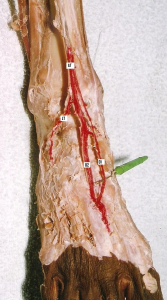International Journal of Anatomical Sciences 2010, 1:37-38.
Case Report
Double Dorsalis Pedis Artery – A Rare Case Report
Vijayalakshmi. S, Varsha S.
Department of Anatomy, Saveetha Medical College, Kancheepuram 602 105, Tamil Nadu, India
Key Words: dorsalis pedis artery, anomalous, musculocutaneous flap, peripheral pulse
Abstract: Dorsalis pedis artery running on the dorsum of the foot is one of the arteries, where peripheral arterial pulsation is felt. Also the musculo-cutaneous flaps based on dorsalis pedis artery are commonly used for reconstructive surgeries. Hence the knowledge of any variation in the course and distribution of dorsalis pedis artery is clinically important. Here a rare case of anomalous dorsalis pedis artery is presented.
The change in lifestyle in this 21st century has increased the number of diabetic patients. It has become a challenge to the health care providers to deal with the complications due to diabetes. Long standing and neglected cases have been seen to end up with diabetic neuropathy and diabetic foot ulcers. These non healing ulcers are challenging problems, for surgeons, which are commonly dealt with by musculocutaneous flaps based on the branches of dorsalis pedis artery.
Dorsalis pedis artery of the dorsum of foot is the continuation of anterior tibial artery seen in 1st intermetatarsal space, where it dips into the sole, between the heads of 1st dorsal interosseous muscle to complete the plantar arch. In the foot it gives off medial and lateral tarsal arteries, arcuate artery and first dorsal metatarsal artery (William et al., 1989).
Case Report
During routine dissection of the lower limb of a male cadaver, aged around 60 years, the anterior tibial artery (AT) on the right side divided into three branches midway between the two malleoli. Among the three branches, lateral tarsal (LT) artery was the lateral most, supplying tarsals. The two medial branches ran side by side together on the dorsum of the foot to reach the first inter-metatarsal space. The lateral one (D 2) of the two dipped in the proximal aspect of the space to join the plantar arch.
The medial branch (D 1) continued as 1st dorsal metatarsal artery. Both these arteries gave medial tarsal branches. Arcuate artery was absent in this case.
Discussion and conclusion
Since ages interesting anomalies of the dorsalis pedis artery have been noted by the anatomists and surgeons. According to Huber in his study in1941, the dorsalis pedis artery was found to arise from the perforating branch of peroneal artery and deviated either medially or laterally in 3% of the cases. In another study by Bailleul et al., in1984 it was found that in 15 out of 67 specimens dorsalis pedis artery divided into two terminal branches 3cm distal to its origin. In this study the author also suggested arteriography to be taken prior to foot flap surgeries. In 1994, Maral et al., studied the pattern of dorsalis pedis artery and found in around 8% of the cases the dorsalis pedis artery was the continuation of peroneal artery.
Fig. 1 Photograph of the dorsum of the right foot.
(AT- Anterior tibial artery; LT- Lateral tarsal artery ; D1 &D2 – Medial and lateral dorsalis pedis arteries)
In the present study two dorsalis pedis arteries were seen arising from the anterior tibial artery. Both the arteries ran side by side to reach first intermetatarsal space, one dipping in the proximal aspect of the space and the other continued as 1st dorsal metatarsal artery. The aberrant arteries or anomalous course of the arteries of the lower limb can be attributed to their development. The axis artery of the lower important role in the normal arterial morphogenesis of the lower limb. The tiny blood vessels derived from the blood islands in the 3rd and 4th week of development merge with each other forming a continuous network of fine vessels. New vessels buds out from the walls grow out and get canalized to form newer vessels. These newer vessels of the neighbouring areas join to form a closed network. The adult arterial pattern of the lower limb develops from multiple and plexiform sources of vessels, and emergence of anastomoses between these vessels, which is followed by regression of some channels depending on the functional dominance. This explains why the anomalies of the blood vessels of the limbs not only present as divergence in the origin and course but also as supernumerary vessels in the region (Sadler,1985) (Kesavi et al., 2002).
Since the dorsalis pedis artery serves as an important pedicle for most of the reconstructive surgeries of the foot, the knowledge about the aberration of the usual anatomic pattern of origin, branching and anastomosing patterns of the artery are of prime importance to the general surgeons, orthopaedic surgeons, plastic and reconstructive surgeons who deal with this area.
References
Bailleul.JP, Olivez.PR, Mestdag.H (1984) Desgra- phical anatomy of the dorsalis pedis artery of the foot. Bull Association of Anatomy (Nancy), 68:15-25.
Huber JF (1941) The arterial network supplying the dorsum of foot. Anat Res, 80: 373.
Kesavi.D, Singh K, Melani RS (2002) Anomalous course of dorsalis pedis artery. Anatomical Adjuncts, 3: 29-31.
Maral TM, Celik TC (1994) Anomalous dorsalis pedis artery. Surg Radiol Anat, 6: 319-323.
Sadler TW(1985)In: Langman’s Medical limb develops from the 5th lumbar Embryology, 68-69.
William I, Walwick R, Dyson M (1989) In: Gray’s Anatomy 37th Edition, Edinburg: Churchill Livingstone. 1572.

